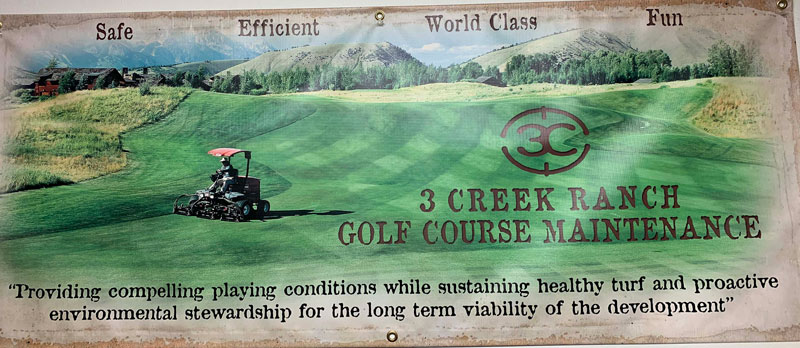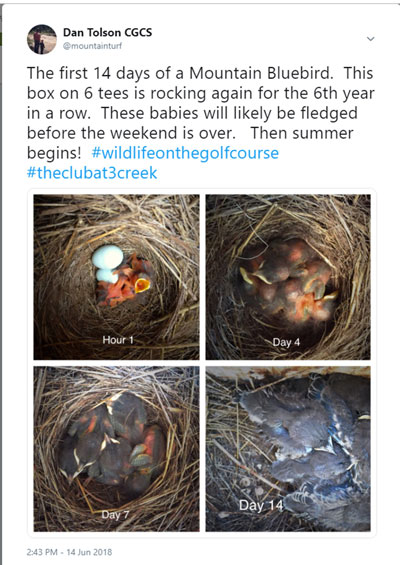
Golfers hit approach shots into the 14th green at The Club at 3 Creek, which is set against the dramatic backdrop of the Grand Tetons in Jackson, Wyo. Author Dan Tolson, CGCS, oversees the private 18-hole championship course, ranked by Golf Digest among the top 5 in the state. Photos by Dan Tolson
Editor’s note: This article was originally published in the May 2019 issue of The Perfect Lie, a publication of the Peaks & Prairies Golf Course Superintendents Association.
“Do more with less.” We’ve all heard the instruction. It’s tossed around so regularly that it can seem like a fad. It often precedes notification from a board member that your budget has been cut, or a rant from a superintendent who is dealing with shrinking resources.
In a “do more with less” industry and when coping with factors outside one’s control — such as Mother Nature and a fickle economy — golf course superintendents can still find success regardless of budget size. No matter whether your operating budget is six digits or seven, growing or shrinking, there are certain things you as a superintendent can control that are unrelated to finances. The following four “Ts” are tweaks that will allow you to do more with less and make huge improvements to your operation — free!
1. Tune your culture
Ever worked for a screamer? How about an “Eeyore” who is always convinced the glass is half-empty? No one likes working in a negative environment, but unfortunately, such managers still exist, and the attitudes that managers project are reflected in their staffs.
In the modern world, if we are going to successfully recruit staff in a highly competitive job market, we don’t have much choice but to create a culture where employees enjoy coming to work and feel valued.
In the book “Drive: The Surprising Truth About What Motivates Us,” author Daniel Pink dissects how three intrinsic motivators can do more to create an outstanding workforce than any external motivators such as salary or benefits. By offering autonomy (the ability to be self-directed), mastery (continual improvement) and purpose (working for a transcendent cause), superintendents can lead their staff members from being robots who are working only for a paycheck to being “think-for-themselves” partners who are engaged in pursuing the success of the operation.

The sunrise lights up hole No. 16 at The Club at 3 Creek. The course was designed by Rees Jones and opened in 2005.
It’s not always easy to apply these three motivators to a golf course maintenance staff, as the problems we’re usually trying to solve just aren’t that complicated. Identifying your core values, crafting unique mission and vision statements, and holding your staff accountable to these will naturally guide them toward the three intrinsic motivators.
As you consider what you want your culture to be, start with core values. What are you passionate about? What is your automatic default that you can’t compromise on, even if you wanted to? Your answers to these questions will point to who you are and what’s most important to you — your core values. Distill those down into a few concise words or a statement to define your department.
As you lead and your crew follows, they will begin to share those same core values, and those values will define your culture. From there, you can establish a mission statement (why you are there) and a vision statement (where you are going). Workers will enjoy their work more if they know what they are there to do and why. Once you know what your vision is, you can begin to set tangible goals. Once goals have been set, turn your staff loose to accomplish them, and boom! You’ve created autonomy, mastery and purpose, and the resulting intrinsically motivated employees.
This topic is the subject of untold dozens of leadership books, and I have just skimmed the surface here. The most important thing to remember as you begin to tune your culture is that the single biggest improvement you can make to your operation is to become a better manager of people. Personally, I have a long way to go in this regard, but I’ve attempted to become a student of the subject. Find some books that move you, study them, and put their principles into practice.
2. Teach your standards
Standards of performance make it possible to hold employees accountable and create a consistent product, and they streamline training. Having a golf course maintenance staff working without written and clear standards is like flying a plane with your eyes closed.
Standards set the bar to get everyone on the crew shooting for the same goal, and they are a clear communication tool for your golfers on what they can expect to find on the course. Most courses have some kind of written standard, usually within the pages of an employee handbook given to employees on their first day and then buried at the bottom of a locker, never to be seen again. So, how do you get your standards translated off the page and into actions by everyone on your staff, day in day and day out?
Standards should be as short and concise as possible while still getting the point across. Here at The Club at 3 Creek, we have our standards in our manual, broken down by area, with a short bulleted list of expectations for each area and a photo of what we expect each area to look like every day. A picture speaks a thousand words, and you should incorporate such visuals into your daily training. Thanks to the pictures in our manual, a new employee can understand what our expectations are for every area of the golf course in less than an hour.

A banner that hangs in the maintenance department’s break room at The Club at 3 Creek communicates the department’s core values and mission.
If a picture is worth a thousand words, a video is worth a novel. Don’t overlook the power of the video recorder right in your pocket. Years ago, the instructional “Superintendent’s Video Magazine” videos were available to help train course staff on the various facets of golf course maintenance. I remember the VHS tapes droning on in the break room, and how we used to have to pause the tapes to explain how our course was different from the Florida course in the video.
Nowadays, with the abundance of video editing apps, you can shoot a clip from your own golf course on your phone, turn it into a short video and have it posted to YouTube in 15 minutes without ever leaving your cart. The iMovie app is a good one that’s easy to use and comes free with every iPhone.
Some people do learn by reading, but in my experience, very few. There is a reason for the explosive growth and success of “YouTube University.” Most people learn by watching others. Videos communicate through language barriers, and they can also save you time by eliminating the need to demonstrate the same thing over and over to different people. If you have a chronic problem with some aspect of your training program, try making a video of someone doing it the right way and see whether that resolves the problem.
3. Track data
Goal setting and goal accomplishment are much more difficult if you aren’t keeping track of data. Knowing data such as payroll numbers, chemical usage, mowing frequency, etc., will help you make educated and confident management decisions.
I admit, I’m guilty of being a data-head. I have files full of records that I haven’t looked at in years. But I save them, just in case someday I need to compile a report. Collecting data is important and, if done right, can greatly enhance your operation.
If you have a certain area you want to improve, start by gathering intelligence about that area. Maybe you think you need a new irrigation system. Do you know exactly how much you spent last year repairing breaks and hand watering? How many gallons of water did you use? Was that less than the year before, or more? What is the five-year trend of irrigation costs? Without clear and accurate answers to those questions, persuading your owner or board to drop $2 million on an irrigation system would be very difficult. And maybe, when you have those answers, you’ll realize you don’t need a new irrigation system as much as you thought you did.

A summer storm passes behind the ninth green at The Club at 3 Creek.
In the old days, tracking data like this was done with a pen and a yellow tablet. It took a meticulous mind to keep track of it all, file it and compile it into something usable. Thanks to modern technology, we can now automatically gather metrics on just about anything and then use apps and computer programs to translate that information into beautiful charts and graphs.
For the do-it-yourselfer, Google offers an abundance of tools. Using Google Forms, you can create an easy form for your crew to fill out (they all have a phone in their pocket, capable of anything) to track everything from greens moisture to bunker sand depth. At the end of the week, export the form to a spreadsheet and filter out the pertinent info. Best of all, it’s free — all you have to do is create a Google account.
If you have a little cash to spend to track labor and other metrics, there are some great companies that offer online platforms for a small monthly fee. At my course, we use the ASB taskTracker, and in my humble opinion, it’s worth every penny. I’m not endorsing it over other products, but it’s a perfect fit for us to beautifully merge a daily digital job board with labor tracking for every job on the golf course.
We now have five years of accurate data for every area on the course. Come fall budget time, my board will receive concrete numbers of payroll details from the prior three to five years, supporting the labor numbers I’m requesting. It makes budgeting much easier and gives credibility to requests for increases.
4. Take inventory
Every golf course is unique and has something to offer that no other course can, whether that’s a beautiful stream flowing through the center, a compelling, historic past, the “best” greens in town, perfect bunker sand, environmental significance, or another attribute. If you want to make your course better, find a way to set it apart from the competition. Take an inventory of what makes it special, then leverage that difference for your benefit.

Lots of superintendents across the country do a wonderful job at this. Through social media and in their communities, they loudly tell the story of what makes them special.
When you think of golf in Northern California, what comes to mind? The seventh hole at Pebble Beach. When conversation shifts to wildlife on golf courses, Paul Carter’s Eagle Cam at The Bear Trace at Harrison Bay in Tennessee usually comes up in the discussion.
Granted, those examples are outliers and not feasible at all golf courses, but when your golfers are sitting around the breakfast table talking about your canvas, what do you want them to talk about? Wouldn’t you rather they focus on an asset or something positive than complain about the slow greens or bunker sand?
As the superintendent, you have the greatest influence to leverage your best assets. Take an inventory of what makes you distinct, and then take steps to maximize its impact. If the asset you want to leverage isn’t quite where you want it to be, set some goals to make it better (see above).
Despite popular opinion and contrary to most of the grumblings heard at the bar on a Friday night, it doesn’t take more money to improve your golf course. As a manager in charge of the most valuable asset at your facility, you have the power to create a positive culture with a clear mission. After you have everyone headed in the right direction, employ clear standards along with photos and videos to teach your staff what you expect of them. Tracking data will allow you to set and accomplish smart goals, and leveraging the assets that make your club special will help distinguish it from all the others.
Before you know it, golfers will be flocking to your course, business will be booming, and that growth in the budget you’ve always longed for will follow.
Dan Tolson, CGCS, has been the superintendent at The Club at 3 Creek in Jackson, Wyo., since 2007. He is a 19-year member of GCSAA and a past president of the Peaks & Prairies GCSA.